|
[1]
|
Yu G, Gao J, Hummelen JC, et al. (1995) Polymer photovoltiac cells: Enhanced efficiencies via a network of internal donor-acceptor heterojunctions. Science 270: 1789. doi: 10.1126/science.270.5243.1789

|
|
[2]
|
Halls J, Walsh C, Greenham N, et al. (1995) Efficient photodiodes from interpenetrating polymer networks. Nature 376: 498. doi: 10.1038/376498a0

|
|
[3]
|
Ma W, Yang C, Gong X, et al. (2005) Thermally stable, efficient polymer solar cells with nanoscale control of the interpenetrating network morphology. Adv Funct Mater 15: 1617–1622. doi: 10.1002/adfm.200500211

|
|
[4]
|
Dennler G, Scharber MC, Brabec CJ (2009) Polymer-Fullerene bulk-heterojunction solar cells. Adv Mater 21: 1323–1338. doi: 10.1002/adma.200801283

|
|
[5]
|
Xie Y, Zabihi F, Eslamian M (2016) Fabrication of highly reproducible polymer solar cells using ultrasonic substrate vibration posttreatment. J Photon Energy 6: 045502–045502. doi: 10.1117/1.JPE.6.045502

|
|
[6]
|
Zabihi F, Chen Q, Xie Y, et al. (2016) Fabrication of efficient graphene-doped polymer/fullerene bilayer organic solar cells in air using spin coating followed by ultrasonic vibration post treatment. Superlattice Microst 100: 1177–1192. doi: 10.1016/j.spmi.2016.10.087

|
|
[7]
|
Anderson TE, Köse ME (2016) Impact of solution casting temperature on power conversion efficiencies of bulk heterojunction organic solar cells. J Photoch Photobio A 318: 51–55. doi: 10.1016/j.jphotochem.2015.11.026

|
|
[8]
|
Oklobia O, Shafai T (2013) A quantitative study of the formation of PCBM clusters upon thermal annealing of P3HT/PCBM bulk heterojunction solar cell. Sol Energ Mat Sol C 117: 1–8. doi: 10.1016/j.solmat.2013.05.011

|
|
[9]
|
Vanlaeke P, Swinnen A, Haeldermans I, et al. (2006) P3HT/PCBM bulk heterojunction solar cells: Relation between morphology and electro-optical characteristics. Sol Energ Mat Sol C 90: 2150–2158. doi: 10.1016/j.solmat.2006.02.010

|
|
[10]
|
Oklobia O, Shafai T (2013) A study of donor/acceptor interfaces in a blend of P3HT/PCBM solar cell: Effects of annealing and PCBM loading on optical and electrical properties. Solid State Electron 87: 64–68. doi: 10.1016/j.sse.2013.05.005

|
|
[11]
|
Wang Q, Xie Y, Soltani-Kordshuli F, et al. (2016) Progress in emerging solution-processed thin film solar cells-Part I: polymer solar cells. Renew Sustain Ener Rev 56: 347–361. doi: 10.1016/j.rser.2015.11.063

|
|
[12]
|
Reyes-Reyes M, Kim K, Carroll DL (2005) High-efficiency photovoltaic devices based on annealed poly(3-hexylthiophene) and 1-(3-methoxycarbonyl)-propyl-1-phenyl-(6,6)C61 blends. Appl Phys Lett 87: 083506. doi: 10.1063/1.2006986

|
|
[13]
|
Reyes-Reyes M, Kim K, Dewald J, et al. (2005) Meso-structure formation for enhanced organic photovoltaic cells. Org Lett 7: 5749–5752. doi: 10.1021/ol051950y

|
|
[14]
|
Li G, Shrotriya V, Huang J, et al. (2005) High-efficiency solution processable polymer photovoltaic cells by self-organization of polymer blends. Nat Mater 4: 864–868. doi: 10.1038/nmat1500

|
|
[15]
|
Service R (2011) Solar energy. Outlook brightens for plastic solar cells. Science 332: 293.
|
|
[16]
|
Li G, Shrotriya V, Yao Y, et al. (2005) Investigation of annealing effects and film thickness dependence of polymer solar cells based on poly(3-hexylthiophene). J Appl Phys 98: 043704. doi: 10.1063/1.2008386

|
|
[17]
|
Moulé AJ, Bonekamp JB, Meerholz K (2006) The effect of active layer thickness and composition on the performance of bulk-heterojunction solar cells. J Appl Phys 100: 094503. doi: 10.1063/1.2360780

|
|
[18]
|
Nam YM, Huh J, Jo WH (2010) Optimization of thickness and morphology of active layer for high performance of bulk-heterojunction organic solar cells. Sol Energ Mat Sol C 94: 1118–1124. doi: 10.1016/j.solmat.2010.02.041

|
|
[19]
|
Kirchartz T, Agostinelli T, Campoy-Quiles M, et al. (2012) Understanding the thickness-dependent performance of organic bulk heterojunction solar cells: the influence of mobility, lifetime, and space charge. J Phys Chem Lett 3: 3470–3475. doi: 10.1021/jz301639y

|
|
[20]
|
Rim SB, Fink RF, Schöneboom JC, et al. (2007) Effect of molecular packing on the exciton diffusion length in organic solar cells. Appl Phys Lett 91: 173504. doi: 10.1063/1.2783202

|
|
[21]
|
O'Connor B, An KH, Pipe KP, et al. (2006) Enhanced optical field intensity distribution in organic photovoltaic devices using external coatings. Appl Phys Lett 89: 233502. doi: 10.1063/1.2399937

|
|
[22]
|
Breyer C, Vogel M, Mohr M, et al. (2006) Influence of exciton distribution on external quantum efficiency in bilayer organic solar cells. Phys Status Solidi B 243: 3176–3180. doi: 10.1002/pssb.200669172

|
|
[23]
|
Chang CC, Lin CF, Chiou JM, et al. (2010) Effects of cathode buffer layers on the efficiency of bulk-heterojunction solar cells. Appl Phys Lett 96: 263506. doi: 10.1063/1.3456530

|
|
[24]
|
Vogel M, Doka S, Breyer C, et al. (2006) On the function of a bathocuproine buffer layer in organic photovoltaic cells. Appl Phys Lett 89: 163501. doi: 10.1063/1.2362624

|
|
[25]
|
Jiang X, Xu H, Yang L, et al. (2009) Effect of CsF interlayer on the performance of polymer bulk heterojunction solar cells. Sol Energ Mat Sol C 93: 650–653. doi: 10.1016/j.solmat.2009.01.005

|
|
[26]
|
Wang Y, Yang L, Yao C, et al. (2011) Enhanced performance and stability in polymer photovoltaic cells using lithium benzoate as cathode interfacial layer. Sol Energ Mat Sol C 95: 1243–1247. doi: 10.1016/j.solmat.2011.01.012

|
|
[27]
|
Abachi T, Cattin L, Louarn G, et al. (2013) Highly flexible, conductive and transparent MoO3/Ag/MoO3 multilayer electrode for organic photovoltaic cells. Thin Solid Films 545: 438–444. doi: 10.1016/j.tsf.2013.07.048

|
|
[28]
|
Zhao SH, Chang JK, Fang JJ, et al. (2013) Efficiency enhancement caused by using LiF to change electronic structures in polymer photovoltaics. Thin Solid Films 545: 361–364. doi: 10.1016/j.tsf.2013.08.061

|
|
[29]
|
Brabec CJ, Shaheen SE, Winder C, et al. (2002) Effect of LiF/metal electrodes on the performance of plastic solar cells. Appl Phys Lett 80: 1288–1290. doi: 10.1063/1.1446988

|
|
[30]
|
Zhao C, Qiao X, Chen B, et al. (2013) Thermal annealing effect on internal electrical polarization in organic solar cells. Org Electron 14: 2192–2197. doi: 10.1016/j.orgel.2013.05.016

|
|
[31]
|
Yazawa K, Inoue Y, Yamamoto T, et al. (2006) Twist glass transition in regioregulated poly(3-alkylthiophene). Phys Rev B 74: 094204. doi: 10.1103/PhysRevB.74.094204

|
|
[32]
|
Kim K, Liu J, Namboothiry MA, et al. (2007) Roles of donor and acceptor nanodomains in 6% efficient thermally annealed polymer photovoltaics. Appl Phys Lett 90: 163511. doi: 10.1063/1.2730756

|
|
[33]
|
Sariciftci NS, Smilowitz L, Heeger AJ, et al. (1992) Photoinduced electron transfer from a conducting polymer to buckminsterfullerene. Science 258: 1474–1476. doi: 10.1126/science.258.5087.1474

|
|
[34]
|
Brabec CJ, Gowrisanker S, Halls JJ, et al. (2010) Polymer-fullerene bulk-heterojunction solar cells. Adv Mater 22: 3839–3856. doi: 10.1002/adma.200903697

|
|
[35]
|
Park SH, Roy A, Beaupré S, et al. (2009) Bulk heterojunction solar cells with internal quantum efficiency approaching 100%. Nat Photonics 3: 297–302. doi: 10.1038/nphoton.2009.69

|
|
[36]
|
Shah SK, Abbas M, Ali M, et al. (2013) Optimal construction parameters of electrosprayed trilayer organic photovoltaic devices. J Phys D Appl Phys 47: 045106.
|
|
[37]
|
Ali M, Abbas M, Shah SK, et al. (2012) Realization of solution processed multi-layer bulk heterojunction organic solar cells by electro-spray deposition. Org Electron 13: 2130–2137. doi: 10.1016/j.orgel.2012.06.016

|
|
[38]
|
Pope M, Swenberg CE (1999) Electronic processes in organic crystals and polymers, Oxford University Press on Demand.
|
|
[39]
|
Bertho S, Janssen G, Cleij TJ, et al. (2008) Effect of temperature on the morphological and photovoltaic stability of bulk heterojunction polymer: fullerene solar cells. Sol Energ Mat Sol C 92: 753–760. doi: 10.1016/j.solmat.2008.01.006

|
|
[40]
|
Jørgensen M, Norrman K, Gevorgyan SA, et al. (2012) Stability of polymer solar cells. Adv Mater 24: 580–612. doi: 10.1002/adma.201104187

|
|
[41]
|
Hong J, Kim YJ, Kim YH, et al. (2016) Thermally Stable Dibenzo[def,mno]chrysene-Based Polymer Solar Cells: Effect of Thermal Annealing on the Morphology and Photovoltaic Performances. Macromol Chem Phys 217: 2116–2124. doi: 10.1002/macp.201600219

|











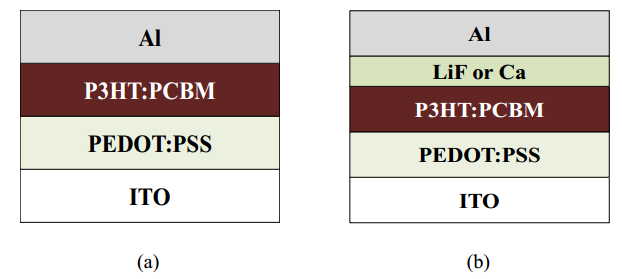
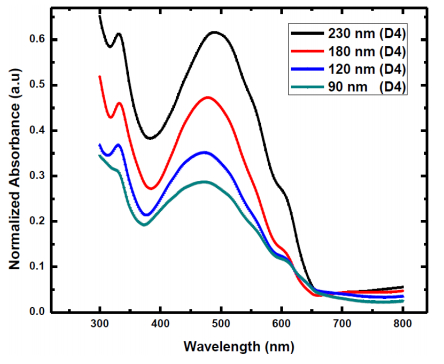
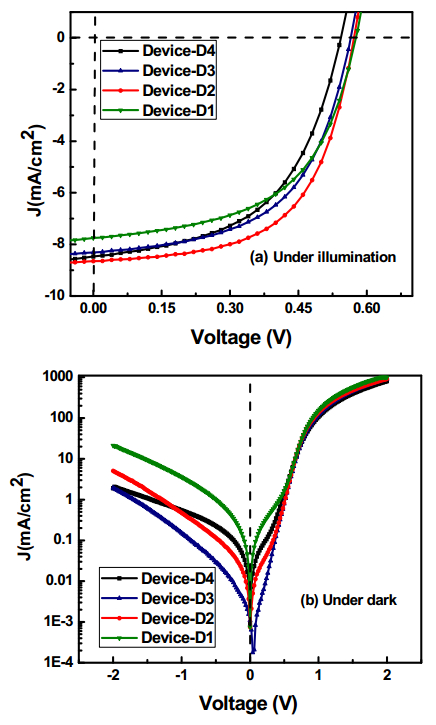

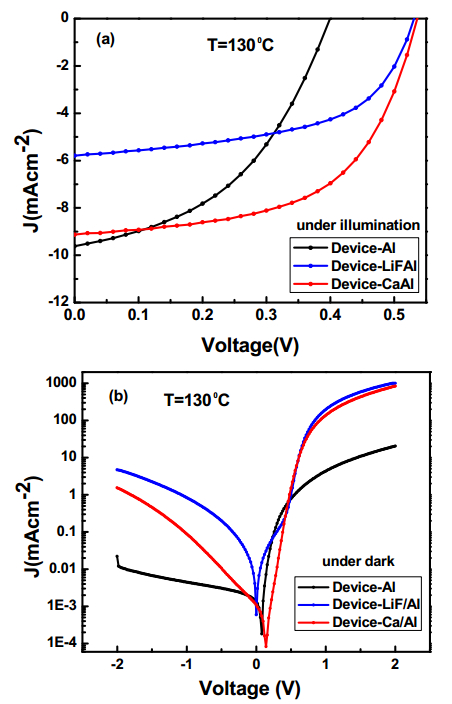
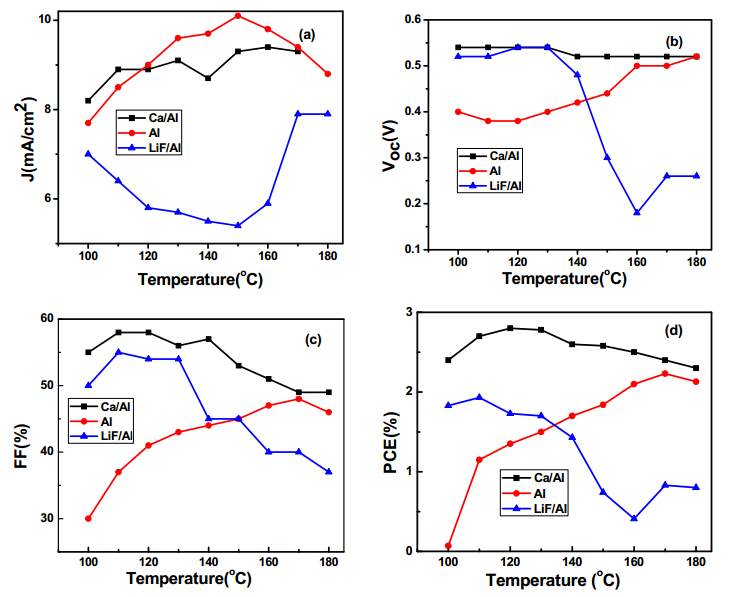


 DownLoad:
DownLoad: